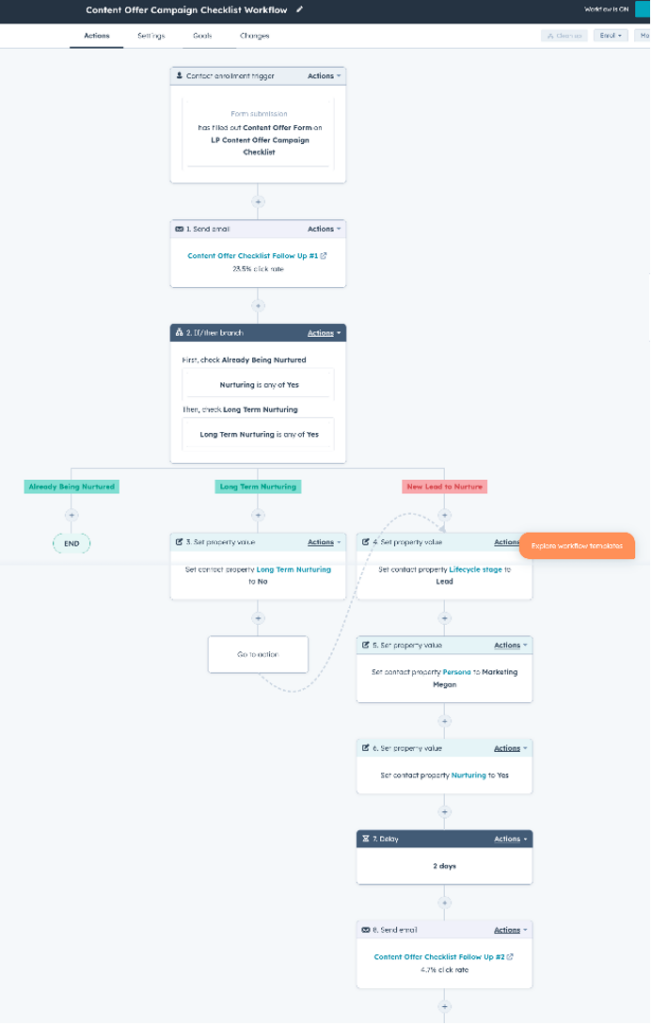Marketing Automation Solutions for Manufacturers
Working in small marketing teams can mean that if anything needs doing that isn’t IT or sales, it finds a way into your inbox.
But you have much more value to your manufacturing company than being part of the ‘make it pretty’ committee. You are also the one who ‘gets it done’.
Marketing can be the bridge between your ideal customer acknowledging an issue they have and working with your company to solve it.
In manufacturing, sales cycles are often complex and involve a huge number of touchpoints. It can take over 9 months to convert high-value manufacturing customers. Automation can improve the consistency and quality of your messaging throughout the user journey.
This article will help you understand how to:
- Reduce manual tasks to create time for you and the sales team to focus on the more valuable parts of your work.
- Improve your working relationship with the sales team and amplify your value within the organisation.
- Increase your ability to track and report on automated activity.
There is a balance between putting the right systems in place and automating for the sake of it. It’s crucial to fully understand the needs of your sales team before trying to help.
Equally, having your customers’ journey mapped out from stranger to customer and beyond will help you determine the most sensible opportunities for marketing automation.
To help you, we’ve compiled tried and tested marketing automation tactics for manufacturing marketing teams.
Related Articles;
Unlocking Success: Digital Marketing Strategies for B2B Manufacturing Companies
Inbound Marketing Strategies for Manufacturers: Tips And Best Practices
From Keywords to Conversions: SEO Strategies for B2B Manufacturers
Driving Success: PPC Advertising Strategies For Manufacturers
The Art of Connection: Social Media Strategies for Manufacturing Companies
From Ideas to Impact: Content Marketing Strategies For Manufacturing Companies
Generating Growth: Lead Generation Strategies for B2B Manufacturing Companies
Email marketing automation for nurturing new manufacturing leads
Even with the best intentions on behalf of your sales team, the level of service your audience receives in learning how you can help them is dependent on morale, training and employee health.
By automating the outreach to prospects, you can remove those variables and raise the minimum standard for how you communicate based on the behaviour of your prospects.
Here is an example of the beginning of a standard email marketing workflow that is setup in HubSpot CRM and is triggered after a user completes a form on a website:

How to use IF/THEN Logic
Most CRMs will include functionality that allows you to set actions powered by IF/THEN logic. This just means that IF something happens THEN something else should happen. Here’s a simple example:

Here, the automation is checking IF the contact has given permission to receive additional marketing messages to the content they requested. IF they have THEN they receive email 1. IF they haven’t THEN the automation ends for them.
Internal emails for key lead activity
A common example of powerful marketing automation we build for manufacturing clients to support their sales teams is a ‘high intent’ workflow.
We ask the sales team to identify an action on behalf of their audience that would suggest a contact is showing intent to purchase their product or service (outside of them completing another ‘contact-us’ form).
Typically, manufacturers say that if a contact visits the price page or revisits the website more than 2 times in 7 days, they’d like their sales team to know.
As a marketer, you can build this automation using your CRM, by triggering an internal email to the contact owner (salesperson) when the contact has visited a certain page on the website.
Here’s what that looks like within HubSpot:

Lead scoring
Do your sales team complain about the quality of leads? Lead scoring is a fantastic way to turn what is often a negative conversation into productive sales support automation.
A lead score gives your sales team a straight-forward and objective way to sort through contacts by their value to the business. But where to start?
Here are some examples of the metrics by which a contact looking for manufacturers could be scored:
- Did the lead complete the form using a professional work email (i.e. not a Gmail/personal email)?
- Did the lead include the optional ‘company name’ field?
- Did the lead identify a budget range, project type or deadline in their response?
In addition to these form-triggered lead scoring parameters, we set incremental lead score influencers :
- Did the lead re-visit the website and view more than 1 page after completing the form?
- Did the lead open any nurturing emails?
- Did the lead click any links within the follow-up automated emails?
- Has the lead booked a call or meeting with a salesperson?
These answers will influence the score of a lead, allowing the sales team to sort by lead score. Here’s how the setup process looks within HubSpot’s CRM as an example:

Lead scoring can be the product of both automatic and manual data collection by the sales team. In the above example, we scored each lead with an additional 10 points where their charity income was found to be higher than £50k. This was something the team investigated on third-party websites and updated the CRM with via a custom property; triggering the +10 points to their lead score.
In addition, if the lead included their website when completing the form, the lead score would pick this up instantly and add 10 points to their lead score.
All of the above automation aims to improve the working lives of your sales team. But what about your life? Let’s look at the marketing automation available to save you time clicking and free up more of your time for thinking.
Social media scheduling
The ability to post on social media across a number of channels and schedule posts for the future is not new, but the best tools to use are constantly evolving.
As a marketing agency, we’ve used a whole host of social media scheduling tools for our and past clients’ content. Each tool has its quirks and pitfalls. Ultimately, it comes down to what works best for the channels you’re producing content for.
As a Manufacturer, you’ll likely want to prioritise LinkedIn and Facebook. There’s an argument to be made for posting on Instagram too; for behind-the-scenes/team content (for recruitment purposes).
For these channels, the following scheduling tools are recommended:
- HubSpot: There is a social media scheduler with the ability to analyse post engagement included in the Marketing package:
- Later – A relatively entry-level social media tool that recommends captions and hashtags, creates analytics dashboards and schedules posts. You can also reply to your messages and comments within the app. Plus there is access to a library of images through Later’s Unsplash photo library:
Reporting and analytics automation
Gone are the days of exporting a data set from a database to Excel and reformatting it with a combination of formulas and pivot tables to report on performance. Marketing technology and systems are available to support automated live-reporting within customisable dashboards for the key stakeholders in your business.
Whether you’re using a market-leading CRM like HubSpot, or reporting tools like SWYDO; your reporting dashboards need to be able to communicate how your marketing is doing quickly and via a scheduled send.
In the past, the time it would take to produce reports for marketing meetings would mean you’d be making decisions off of old data. Now, as long as you have connected your website to your CRM and ad accounts, you can start to build a live feed of business performance from a single source of truth. Furthermore, that live feed can be automated to be sent out on a reasonable reporting cycle.
Custom software to connect systems e.g. your stock system and your CRM
One of the relatively under-represented and potentially under-valued areas of marketing is getting everything to work.
A quick-fire quiz for you:
- Does your product stock system connect to your CRM?
- Does your CRM connect to your website?
- Are the leads from your ads campaigns automatically migrated to your CRM?
If you said yes to 3 out of 3 of the above, you probably have an experienced web developer working with you and/or you are making use of an Integrated Platform as a Service (iPaaS) like Zapier or LeadsBridge to connect your systems.
What is iPaaS?
iPaaS make it easy to connect and manage different apps, services, and data, whether they’re stored on your own servers or in the cloud. This works not just for one company, but can also link multiple organisations together where that data is stored by third-party companies.
Helping clients connect systems has become a huge part of the work we do at Web Presence, using our in-house team of developers based in the UK. If you work for a manufacturer and would like to know more about how we’ve helped other similar companies connect stock systems with CRMs and websites, get in touch.
Automation for best practices
The objective here is to build and repeat best practices as part of an automated process. This is so that your business’s ability to hit your objectives isn’t affected by a person’s ability or motivation to manually complete their tasks every workday.
A strong Customer Relationship Management system will allow you to set up all of the marketing automation listed above, but make sure you do your research on the pricing to understand whether it includes all the features you need.
HubSpot is a market-leading CRM that has different licences that cater to a number of use cases and requirements. A better place to start than an expensive software purchase is to understand where you can make the most difference to your overall inbound marketing.
Identifying the business need for automation
Step 1: Speak to the sales team
There are countless historic examples of over-engineered solutions to problems that never existed. We don’t need to invent an anti-gravity space pen when a pencil will do.
Step 2: Identify which manual tasks represent best practice that can be automated.
Step 3: Calculate the cost of the current way of working in hours plus the potential benefit that the reliability of automation will bring.
Marketing Automation for Manufacturing Companies.. In Summary
If you’re in a small marketing team for a manufacturing company, you’ve got more to offer than just making things look good. You can:
- Make things work.
- Make the sales team look good.
- Be the gel in the company’s sales and marketing systems.
The sales cycle can be a long slog, but marketing automation can help keep your messaging on point. You can use tools like HubSpot to set up email workflows and lead scoring to help your sales team focus on the hot prospects.
Social media scheduling tools an help you manage posts and track performance.
And don’t forget about reporting; you’ve got options to automate that too, so you’re not stuck in Excel hell. Before you dive into automation, though, talk with your sales team to figure out what actually needs automating.
If you want some support on where to start, at Web Presence we build and improve sales and marketing automation successfully for manufacturing companies. We can share our processes on a call and discuss how you should start your next project.




